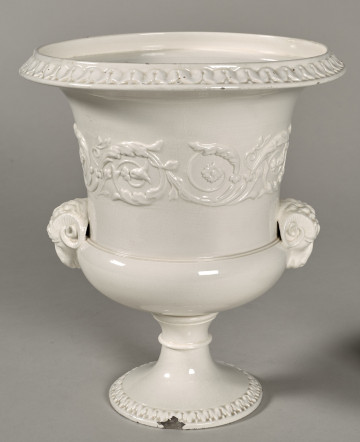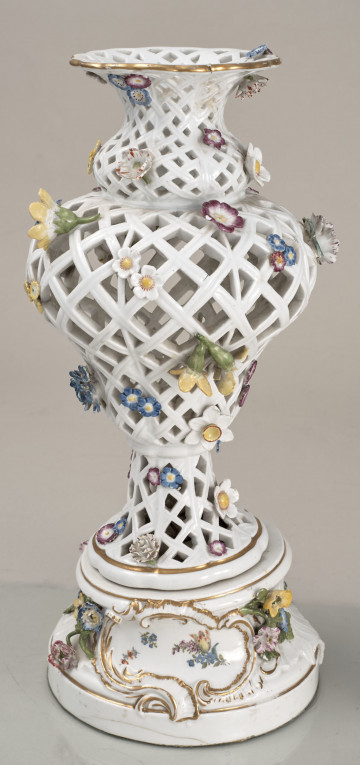
Service vase (pattern of field grasses)
1812 — 1813
Castle Museum in Łańcut
Part of the collection: ceramics
Vase-terrine decorated with miniatures The vase was made in the porcelain factory in Meissen, in the years 1740-1745. Founded by Augustus II the Strong in 1710, it was the first European porcelain factory. It is an oval vase with side handles shaped like macarons, with a dome-shaped convex lid, and in a grand gilded bronze setting. The setting is a base modelled into a rock, from which four snakes grow out; the snakes form the handles of the vessel and slither along the openwork gallery which separates the vase from the lid. The handle of the lid is also made of gilded bronze; it is shaped like a flower bud with a butterfly (originally, the lid was topped with a ball which has been polished off). The vase is decorated with multicoloured painted miniatures, enclosed in rich, lacy, four-arched, gilded frames complemented with red and purple. The paintings depict hunting scenes, mounted men heading towards buildings with defensive architecture, and wandering figures against the background of a meticulously recreated panorama. The vase was made according to the model by Johann Gottlieb Kirchner and the handles, according to the 1733 model by Joachim Kaendler, an outstanding sculptor-modeller in the Meissen factory. The paintings adorning the vase are of high artistic standard; they might have been created by J. G. Heine, a student of Johann Gregorius Höroldt, the manager of the painting shop, employed in the Meissen factory in the years 1721-1746. In the Meissen factory, painted adornments have become an essential decorative element of the products since 1720, i.e. the year in which Johann Gregorius Höroldt took over the management of the painting shop. The Chinese themes, dominant until then, gave way to genre and landscape painting over time. The Łańcut vase is a good example of a product from the period of the greatest flourishing of the Meissen factory, which occurred in the years 1733-1756 (until the Seven Years' War). This period was famous for the high technical and artistic standard of the Meissen products, which were admired throughout Europe. Barbara Trojnar
Author / creator
Dimensions
height: 49 cm
Object type
Ceramics
Technique
gilding
Material
gold, bronze, porcelain
Origin / acquisition method
donation
Creation time / dating
Creation / finding place
Owner
Castle Museum in Łańcut
Identification number
Location / status

1812 — 1813
Castle Museum in Łańcut

19th (?) century
Castle Museum in Łańcut

half of the 18th century
Castle Museum in Łańcut
DISCOVER this TOPIC
National Museum in Szczecin
DISCOVER this PATH
Educational path